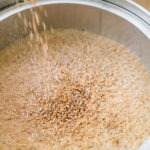Topic: Brewing Science
Explaining Hop Utilization
The term “boil efficiency” typically refers to “hop utilization” and relates hop alpha acids added to wort to iso-alpha acids in beer. I will use the standard term “hop utilization” in this
Understanding Mash Chemistry
Changing the chemistry of the mash can play an important role in the outcome of the final beer. Learn how to make adjustments based on your water and grist.
Hop Creep, Hop Utilization, and a Different Approach to Beer Judging
Hop creep isn’t new, so why are we hearing so much more about it in recent years? Brewing scientists now believe it has to do with a push from brewers for hops to be kilned at lower temperatures to preserve aromatics. The Wizard also gets geeky about hop utilization and shares a different approach to beer competitions.
Artificial or Intelligent?
Artificial intelligence is all around us. We use its recommendations when shopping and selecting shows to binge, rely on its answers to questions and to filter out spam emails. Why not use it to help in our homebrewing hobby? A technologist shares his experiences exploring the applications and potential of AI-assisted homebrewing that may be of service to beginners and longtime brewers alike.
Using a Malt COA to Brew Better Beer
Your Malt COA is a valuable brewing tool if you know how to use the listed numbers. It can be a roadmap to maximize your malt during a brew day and that
pH vs. TA in Sour Beers
pH might not be the most effective method for measuring the perceived sourness when brewing beer. Due to various acid strengths and the buffering capacity of different worts, titratable acidity (TA) is the
Best Practices for Using Thiolized Yeast
Thiol aromas can range from subtle to intense with a wide variety of tropical fruit flavors that can integrate into your beers, whether as a complement to a fragrant hop bill or
Quality Control Fixes: Troubleshooting Brewery QC Test Results
Running quality control tests on your beer is key to improving your brewery’s products. But what do you do when a QC test comes back with results that point to a problem.
Using Enzymes in the Nano Brewhouse
Malted barley, hops, water, and yeast naturally have the fundamental building blocks for great beer. But sometimes your batch might need a little extra helping hand to make it the best it
Understanding & Managing Hop Creep
All those dry-hopped IPAs and Pilsners you brew also can come with a hidden challenge: hop creep. Hop creep from dry hopping can result in a surprise second fermentation lowering gravity while
Your Nano Brewery Lab – Equipment and Tests You Need
It doesn’t require much space or expense to add the basic gear you need to set up a lab for your brewery so you can test your batches and improve quality control.
Are Thiols Worth the Hype?
Having brewed dozens of different beers with thiolized yeasts and thiol-enhancing products, Michael Tonsmeire explains what thiols do to beer, for better or for worse. Learn what thiols are, where they come from, and the impact they have on beer.











